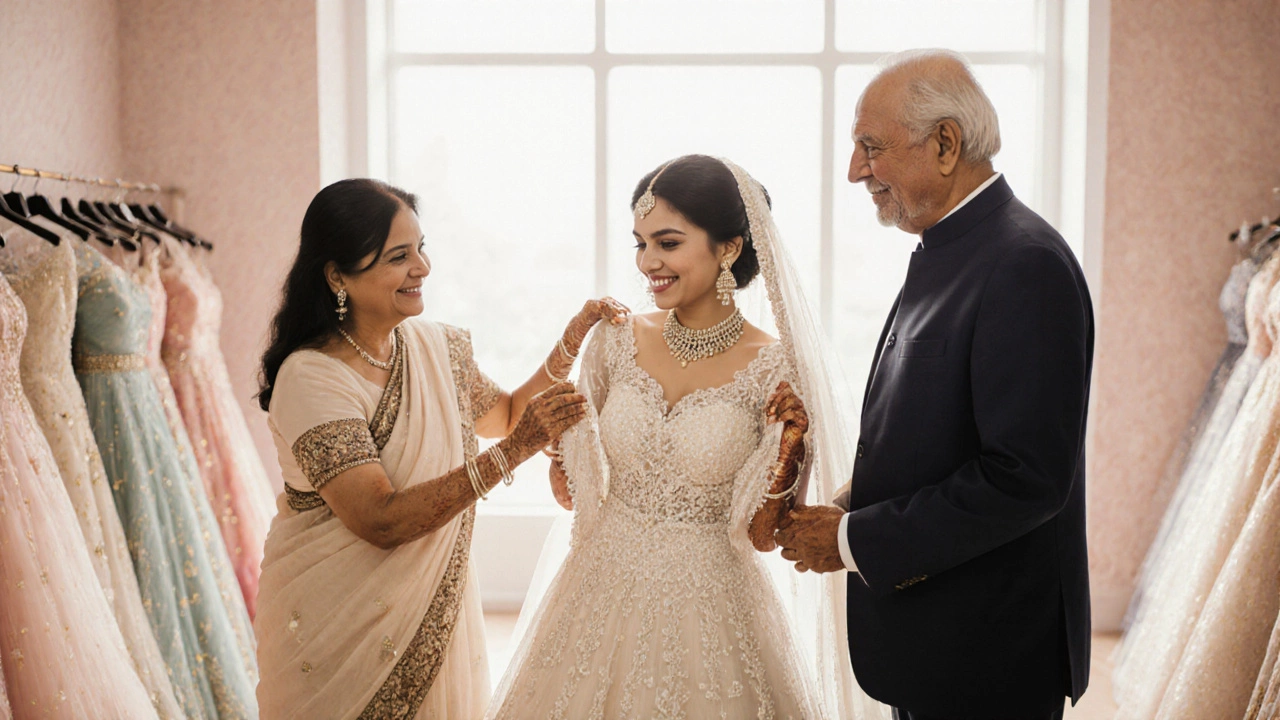Key Takeaways
- Tradition, culture and family dynamics all shape who pays for the dress.
- Modern couples often split costs, but clear communication prevents misunderstandings.
- A budgeting checklist helps you decide what feels fair for everyone involved.
- Understanding regional customs can guide respectful conversations with relatives.
- Use a simple worksheet to track contributions and avoid surprise expenses.
When you start dreaming about that perfect wedding dress is a the centerpiece of most bridal wardrobes, symbolizing the start of a new life together, one of the first questions that pops up is: who’s actually footing the bill? The answer isn’t one‑size‑fits‑all. It depends on cultural traditions, family finances, and the couple’s own preferences. This guide walks you through the most common scenarios, provides a handy decision‑making checklist, and offers a quick cultural comparison so you can handle the conversation with confidence.
Traditional Norms Around the Dress
Historically, the responsibility for the bridal gown often rested on the bride’s family. In many Asian cultures, especially India and China, parents view the dress as part of the dowry or wedding package. In the United States and much of Europe, the custom shifted in the 20th century: the bride and sometimes the groom started covering it, reflecting a move toward individual financial independence.
Understanding these roots helps you anticipate expectations. If your family follows a long‑standing tradition, they may assume it’s “their” expense. If they’re more modern, they might expect you to contribute or even pay the full amount.
Modern Financial Realities
Today’s wedding dresses can range from a few hundred dollars for a simple off‑the‑rack gown to $10,000 + for a couture masterpiece. With venue costs, catering, photography, and a honeymoon on the horizon, the dress can become a surprisingly large line item in an already stretched budget.
Couples are getting smarter about where the money goes. Many set a total wedding budget first, then allocate a percentage-usually 5‑10 %-to attire. This percentage helps keep the dress from eating up funds meant for other priorities, like travel or a down payment on a home.
Who Typically Pays? A Breakdown by Role
- Bride - Often contributes a portion, especially if she’s financially independent or wants more control over style.
- Groom - May cover the dress if the couple prefers a joint budget or if the groom’s family has a tradition of supporting the bride’s look.
- Bride’s parents - In many cultures, they see the dress as part of the wedding “gift” to the couple.
- Groom’s parents - Less common, but some families offer to pay for both the dress and the tux, especially in cultures where the groom’s family handles most wedding expenses.
- Extended family - Occasionally, grandparents or aunts pitch in as a “wedding present,” especially if the immediate family is on a tight budget.
The key is not who *should* pay, but who *wants* to pay. Open up the conversation early, ideally during the budgeting phase, so expectations are clear.

Decision‑Making Checklist
- Set a total wedding budget and earmark 5‑10 % for attire.
- Identify cultural expectations: does your family expect to cover the dress?
- Discuss each partner’s financial contribution comfort level.
- Ask parents directly-preferably in a private, non‑pressured setting.
- Document all agreed‑upon contributions in a shared spreadsheet.
- Revisit the plan after major expenses (venue, catering) are booked.
Having a checklist makes the discussion feel structured rather than confrontational.
How to Talk Money With Your Family
Money conversations can feel awkward, but framing the dialogue around gratitude and shared goals helps. Try these tactics:
- Start with appreciation: "We’re so grateful for all the support you’ve offered so far."
- Be transparent: share the total wedding budget and where the dress fits.
- Offer options: "If you’re comfortable, we could split the dress cost 50/50, or I could cover a portion myself."
- Set a deadline: let them know when you need a decision to keep the dress ordering timeline on track.
- Put it in writing: a friendly email summarizing the agreement avoids future misunderstandings.
Sample Budget Worksheet
| Item | Estimated Cost | Who Pays? | Actual Paid |
|---|---|---|---|
| Dress | $2,500 | Bride + Parents (50/50) | |
| Alterations | $300 | Bride | |
| Veil & Accessories | $200 | Parents | |
| Travel for Dress Fitting | $150 | Bride | |
| Total | $3,150 |
Fill in the “Actual Paid” column as contributions come in. The worksheet makes gaps visible and prompts follow‑up conversations before deadlines.

Cultural Comparison: Who Pays for the Dress Around the World?
| Region / Country | Typical Payer(s) | Modern Trend |
|---|---|---|
| North America (USA, Canada) | Bride (often with help from parents) | Joint contribution or bride covers fully |
| Western Europe (UK, France, Germany) | Bride or joint couple budget | Increasingly split 50/50 |
| South Asia (India, Pakistan, Bangladesh) | Bride’s parents (dowry tradition) | Bride and groom sharing, especially in metros |
| East Asia (China, Korea, Japan) | Bride’s family (gift tradition) | Couple often pays, with parental gift contributions |
| Middle East | Bride’s family (part of wedding feast budget) | Couple may split, especially for modest gowns |
| Africa (Nigeria, Kenya) | Mixed - sometimes bride’s family, sometimes groom’s | Joint contribution becoming common |
These patterns are guidelines, not rules. Your family’s financial situation, personal values, and the style of dress you want all play a part.
Tips for Keeping the Process Stress‑Free
- Shop early: many designers offer discounts for early orders.
- Consider rental or second‑hand options - they can cut costs dramatically.
- Set a firm deadline for payments to avoid last‑minute surprises.
- Keep receipts and a shared folder so everyone can see what’s been paid.
- Remember the bigger picture: the dress is beautiful, but your marriage is what really counts.
Frequently Asked Questions
Is it rude to ask my parents to pay for the dress?
No, as long as you ask respectfully and explain your budget. Most families expect the question and are happy to help when they can.
What if I can’t afford the dress I want?
Consider off‑the‑rack gowns, sample sales, or renting. Many brides find a gorgeous dress for a fraction of the couture price.
Should the groom’s family ever contribute?
If it aligns with cultural norms or the couple’s financial plan, absolutely. A joint contribution can reinforce the partnership feeling.
How much should I budget for alterations?
Typically 5‑10 % of the dress price. Complex designs or custom fittings can push it higher, so add a cushion.
Can I include the dress cost in a honeymoon fund?
Some couples ask guests to contribute directly to a “experience fund,” which can cover the dress, honeymoon, or both. Transparency is key.
By mapping out who’s comfortable paying, having an open dialogue, and tracking every contribution, you’ll avoid awkward moments and keep the focus on the celebration itself.
Next Steps
1. Pull out your wedding budget spreadsheet and set a realistic percentage for the dress.
2. Talk to your partner about the split you both feel is fair.
3. Schedule a quick call with your parents or guardians to confirm their willingness.
4. Choose a dress, lock in the price, and update the worksheet.
5. Celebrate the progress - you’ve just solved one of the biggest wedding money questions!
